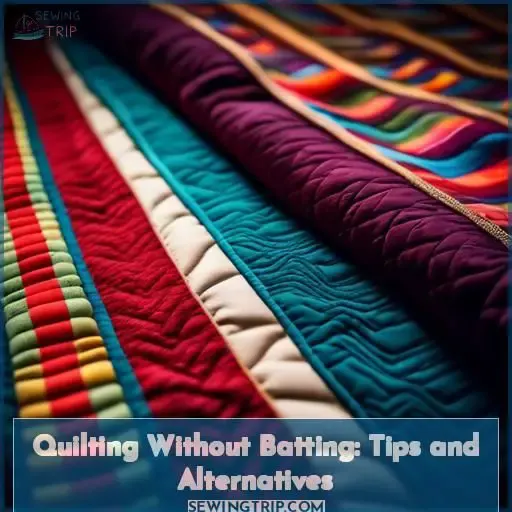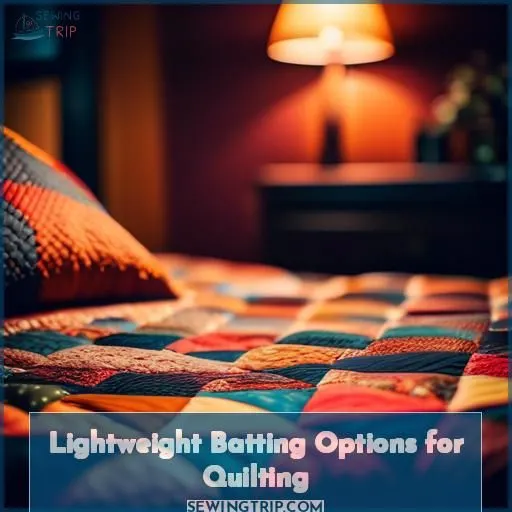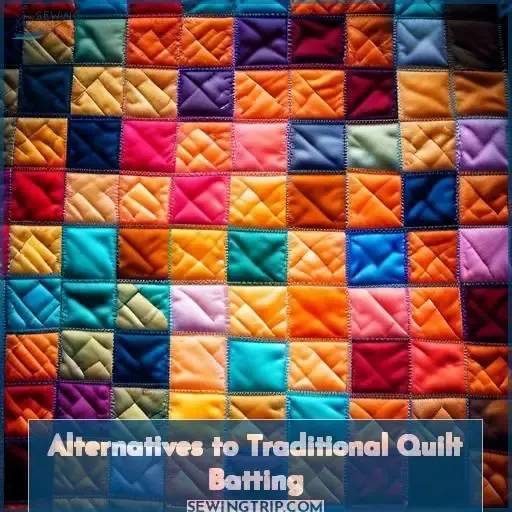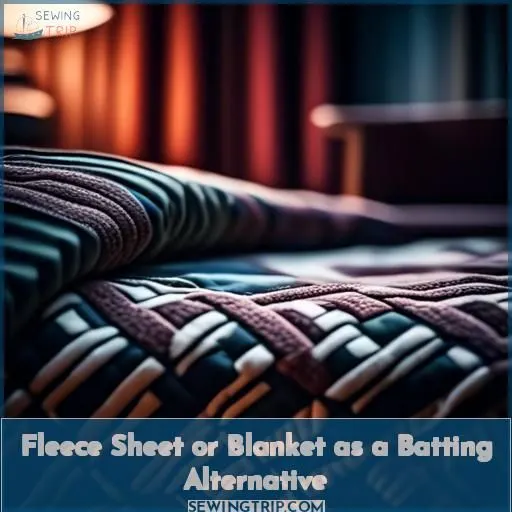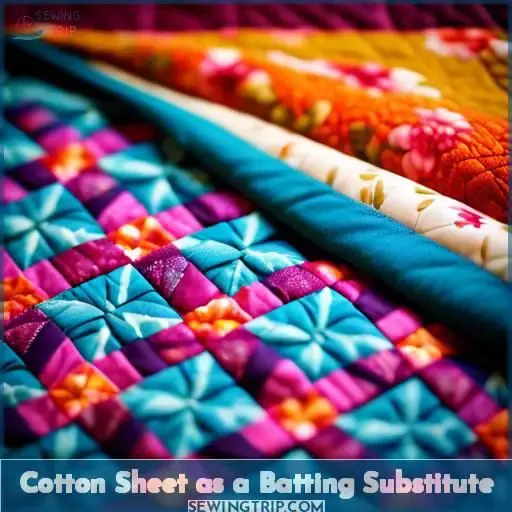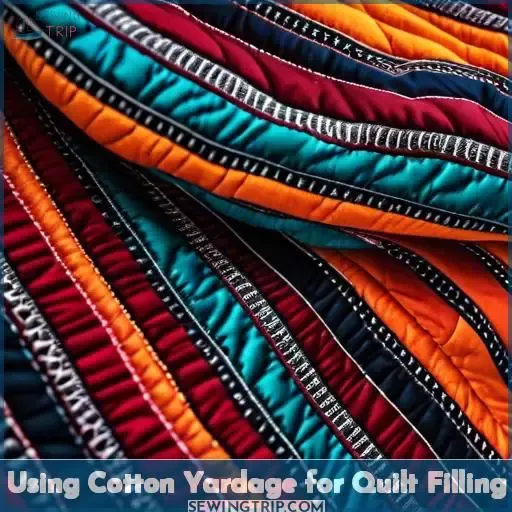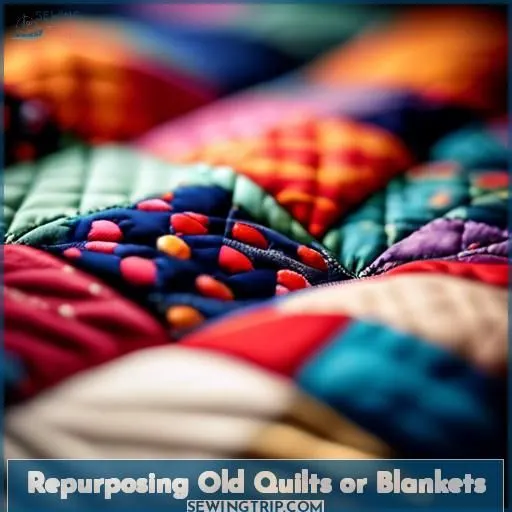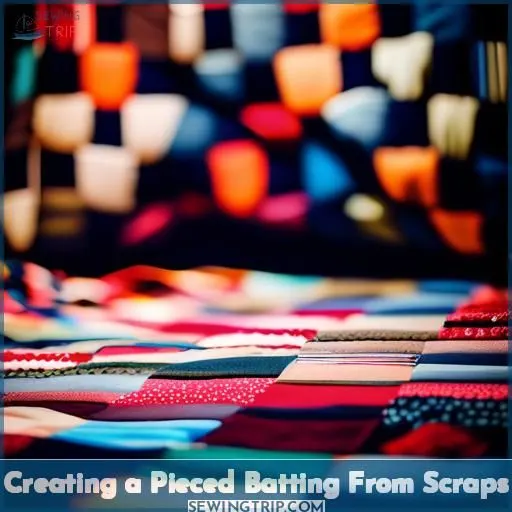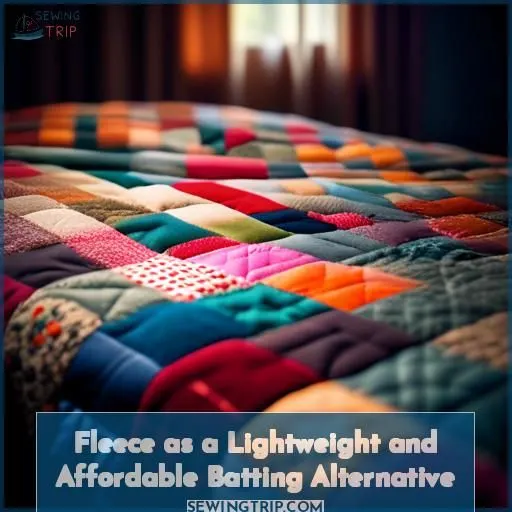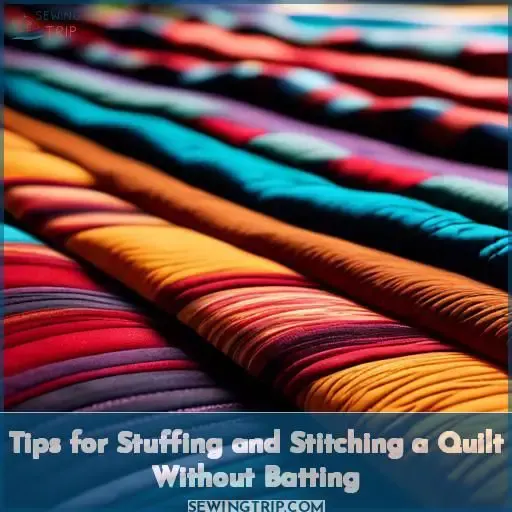This site is supported by our readers. We may earn a commission, at no cost to you, if you purchase through links.
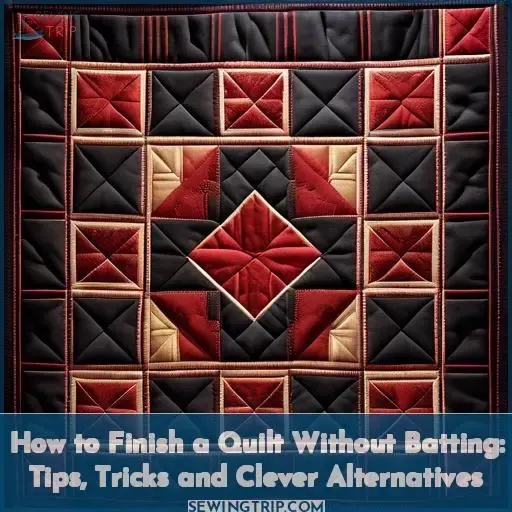
You don’t need batting to finish a quilt without batting! Opt for lightweight alternatives like cotton sheets, fleece blankets, or repurposed fabric yardage.
Layer these between your quilt top and backing for warmth and structure. Pre-wash materials to prevent shrinkage, then baste or stitch layers together.
Cotton sheets provide breathability while fleece offers cozy warmth. Cut fabric into strips to create lightweight filling.
Get creative repurposing old quilts or blankets as batting. Pieced batting assembled from fabric scraps is another clever option.
Without bulky batting, your finished quilt will have beautiful drape – and you’ll discover more possibilities as we explore further.
Table Of Contents
- Key Takeaways
- How to Finish a Quilt Without Batting?
- Quilting Without Batting: Tips and Alternatives
- Lightweight Batting Options for Quilting
- Alternatives to Traditional Quilt Batting
- Fleece Sheet or Blanket as a Batting Alternative
- Cotton Sheet as a Batting Substitute
- Using Cotton Yardage for Quilt Filling
- Repurposing Old Quilts or Blankets
- Creating a Pieced Batting From Scraps
- Fleece as a Lightweight and Affordable Batting Alternative
- Tips for Stuffing and Stitching a Quilt Without Batting
- Frequently Asked Questions (FAQs)
- Conclusion
Key Takeaways
- Opt for lightweight alternatives like cotton sheets, fleece blankets, or repurposed fabric yardage to replace traditional quilt batting, offering breathability and warmth without the bulk.
- Pre-wash materials before use to prevent shrinkage and ensure the quilt maintains its desired shape and size after completion.
- Consider using pieced batting assembled from fabric scraps as a cost-effective and eco-friendly option to create a lightweight quilt filling.
- Employ creative methods such as the pillowcase sewing method for edge finishing, allowing for a beautifully draped quilt without the need for bulky batting.
How to Finish a Quilt Without Batting?
To finish a quilt without batting, you can use the envelope method, which involves sewing the top and backing together without a middle layer. Alternatively, you can use a layer of flannel instead of batting, which can be quilted and bound as usual. Another option is to use a very thin batting, such as Quilter’s Dream’s super thin cotton batting, which can provide a substantial feeling without adding significant bulk. If you prefer a lightweight quilt, you can skip the batting altogether and quilt the top and back together directly.
Quilting Without Batting: Tips and Alternatives
Quilting without batting is a viable option for those who want to create lightweight, breathable quilts for warm weather. By skipping the traditional middle layer, you can reduce weight and experiment with alternative quilting methods. For instance, the pillow sewing method can be used to sew quilt edges together without batting.
When considering lightweight batting options, bamboo is the lightest-weight choice. Bamboo batting is lightweight, breathable, and has a beautiful drape. Cotton is the next most breathable batting option, and choosing 100% cotton batting with a low loft can result in a lightweight quilt. Quilters Dream Bamboo batting and Happy Cloud Bamboo Blend batting** are recommended lightweight options.
For those who prefer not to use batting at all, there are several alternatives. Fleece sheets or blankets can be used as a lightweight, affordable, and available alternative. Cotton sheets can also be used, ensuring neutral colors to avoid patterns showing through the quilt top or back. Cotton yardage can be utilized from your fabric stash or purchased at sales. Old quilts or blankets can be repurposed, adding warmth and character to your quilt. Pieced batting can be created by sewing or fusing together scraps of batting to create a larger piece.
Fleece is a lightweight and affordable alternative to batting. It comes in a variety of colors to coordinate with your quilts, and pre-washing is recommended to prevent shrinkage. The Solid Fleece Bed Blanket by Room Essentials at Target is a recommended option.
Lightweight Batting Options for Quilting
If you’re looking to create a lightweight quilt for warm weather, there are several lightweight batting options to explore. Here are three choices that can help you achieve the desired thickness and loft for your quilt:
- Bamboo Batting: Known for its lightweight, breathable nature, and beautiful drape, bamboo batting is a popular choice for summer quilts. It’s a natural, eco-friendly material that can add warmth without bulk.
- Cotton Batting: Cotton batting is another breathable option, perfect for those who prefer natural materials. Choose a low-loft 100% cotton batting for a lightweight quilt.
- Pieced Batting: If you have remnants of batting, you can sew or fuse them together to create a larger piece. This can be a cost-effective way to create a lightweight batting for your quilt.
Alternatives to Traditional Quilt Batting
Delving into the realm of quilting without conventional batting unveils a treasure trove of creativity and innovation. Here’s how you can conquer this artistry:
- Lightweight Sheets: Replace the heft with airy ease. Lightweight sheets provide breathability options that render your quilts refreshing and comfortable, ideal for those balmy summer evenings.
- Cotton Alternatives: Venture into experimenting with cotton yardage or repurposed cotton sheets. Their intrinsic breathability and softness impart a cozy touch devoid of the weight.
- Pieced Batting: Got remnants? Stitch them together! Pieced batting isn’t merely a cost-effective measure; it’s a testament to resourcefulness and ingenuity, bestowing unique texture and warmth.
- Foam and Polyester Fiberfill: For those seeking a hint of volume without the bulk, these stuffing alternatives proffer a lightweight yet cozy sensation, making your quilt top reverberate with softness.
Fleece Sheet or Blanket as a Batting Alternative
Fleece sheets or blankets can serve as a fantastic alternative to traditional quilt batting. They offer several advantages, including being lightweight, breathable, and having a beautiful drape. Fleece is also warm and soft**, making it perfect for winter projects. Additionally, it’s easier to work with than batting and won’t scratch up your quilt as batting can.
When using fleece as a batting alternative, it’s essential to pre-wash the fabric to prevent shrinkage. This step guarantees that your quilt maintains its desired shape and size. Fleece is available in various colors, allowing you to coordinate it with your quilt’s design. It’s also an affordable option, making it a cost-effective choice for quilting.
One recommended fleece batting option is the Solid Fleece Bed Blanket by Room Essentials at Target. This fleece is a popular choice among quilters due to its softness and affordability.
Cotton Sheet as a Batting Substitute
Cotton sheets are a versatile and affordable alternative to traditional batting for quilting. Here’s how to use them:
- Choose the right thickness: Opt for a medium-weight cotton sheet for the best balance of support and flexibility.
- Pre-wash for best results: Pre-wash your cotton sheet to prevent shrinkage and guarantee a consistent texture.
- Select neutral colors: Choose cotton sheets in neutral colors to avoid patterns showing through your quilt top or back.
- Consider cost and durability: Compare the cost of cotton sheets to other batting options and consider their durability when making your choice.
Using Cotton Yardage for Quilt Filling
If you’re seeking a method to complete a quilt without batting, consider utilizing cotton yardage as a filling material. This can be an excellent choice if you desire to conserve funds, possess a fabric stash, or favor a lighter quilt. Cotton yardage can provide the requisite stability and support without adding bulk, rendering it ideal for quilts that don’t require substantial thickness.
To employ cotton yardage, simply sever it into strips and interpose it between the top and back layers of your quilt. You can suture the layers together using a range of techniques, such as hand or machine quilting, or even fasten the quilt if you so choose. Recall to pre-launder your cotton yardage to forestall shrinkage and guarantee a uniform appearance for your completed quilt.
Although cotton yardage can serve as a cost-effective alternative to conventional batting, it may not furnish the same degree of loft or warmth as batting. If you’re endeavoring to create a lightweight quilt that doesn’t warrant substantial insulation, this could be the optimal solution. Nevertheless, if you’re fabricating a quilt for chillier climes or yearn for a more substantial sensation, you may contemplate employing alternative batting options, such as bamboo batting, fleece, or polyester fiberfill.
Repurposing Old Quilts or Blankets
Repurposing old quilts or blankets can be a creative and sustainable way to finish a quilt without batting. By using these materials, you can add extra warmth to your quilt while reducing waste. Old textiles can be transformed into beautiful and functional items, such as quilted placemats, tote bags, scarves, and pillow covers. These repurposed items can be enjoyed for years to come, keeping the sentimental value alive in a new way.
To repurpose an old quilt, consider the following steps:
- Assess the condition: Check for fading, stains, holes, and tears. If the quilt is in poor condition, it may not be suitable for repurposing.
- Choose the repurposing method: Decide on the item you want to create, such as a quilted jacket, tote bag, or pillow cover.
- Cut and sew: Cut the quilt into the desired size and shape, and sew it together with a lining or backing fabric.
- Add closure: For items like jackets and tote bags, add a zipper or buttons for closure.
Creating a Pieced Batting From Scraps
Creating a pieced batting from scraps is an excellent way to conserve batting and reduce waste in your quilting projects. By piecing together smaller pieces of batting, you can create a larger, continuous piece without the need for a middle layer. This technique is eco-friendly and aligns with the principles of upcycling textiles, which is a sustainability measure that prolongs the lifecycle of textiles and reduces unnecessary production.
To piece batting scraps, you’ll first need to prepare your batting pieces. Begin by laying two pieces of batting together, with an overlap of 1/2 to 3 inches, depending on the cutting method you use. If you prefer a straight edge, use a rotary cutter to cut down the center, removing the scraps to reveal two edges that will abut to each other perfectly. If you don’t have a large enough piece of batting on your cutting mat or prefer not to use a rotary cutter, you can use scissors to cut the edges, although the edges won’t be as perfect.
Once your batting edges are prepared, you have a few options for piecing your batting scraps together. You can sew the pieces together by machine or hand, or use a fusible product to hold them together. When sewing the pieces together, remember that you’re just basting it until the actual quilting is done, as your quilting stitches will hold it all together. Use a neutral/matching thread to sew your batting pieces together, and make sure your stitches are loose enough to prevent puckering or bunching.
Alternatively, you can hand stitch the pieces together, placing them on a hard surface and making big stitches down the seam, keeping the stitches fairly loose. This method can be back-breaking, but it’s an option if you feel the batting is secure enough.
Another option is to machine zig zag stitch the layers together, using the biggest stitch your machine will make and ensuring the batting isn’t puckering or bunching. If the batting is puckering a lot, try adjusting the tension or using a larger stitch.
Finally, you can use fusible tapes to hold the pieces together, although this method hasn’t been tried by the author.
Fleece as a Lightweight and Affordable Batting Alternative
Fleece is a fantastic alternative to traditional batting for quilting. It’s lightweight, warm, and incredibly affordable, making it a popular choice for many quilters. When using fleece, consider its color options to coordinate with your quilt. Pre-washing is essential to prevent shrinkage, especially if you plan to use multiple colors. Fleece is widely available, often in a variety of colors and patterns, and can be found at most home goods stores or online.
If you’re looking for a more affordable option, consider purchasing a pre-washed fleece bed blanket. These are often available in large sizes, making them perfect for quilting. For a more natural, breathable alternative, choose 100% cotton batting with a low loft. Alternatively, you can repurpose an old quilt or blanket, or even use a bed sheet as a backing.
Tips for Stuffing and Stitching a Quilt Without Batting
Stuffing and Stitching a Quilt Without Batting: Tips and Techniques
When it comes to quilting without batting, there are various ways to achieve a beautiful and functional quilt. Here are some tips and techniques to help you get started:
- Choose the Right Fabric: Select a lightweight, smooth cotton fabric for the top layer of your quilt. This will provide a cooler alternative to batting and allow for easier stitching.
- Consider the Quilt Size: Smaller quilts may not require batting, as the fabric layers will hold together better. However, larger quilts may benefit from a backing fabric or a layer of flannel for added stability.
- Embellishment Options: Quilting without batting opens up more opportunities for embellishments. Consider using embroidery, appliqué, or other decorative techniques to add interest to your quilt.
- Machine Stitching Techniques: Use a walking foot or a free-motion foot on your sewing machine to ensure smooth stitching and prevent puckering. This will help you achieve a professional-looking finish.
- Hand Stitching Alternatives: If you prefer hand-stitching, consider using a needle and thread to sew the layers of your quilt together. This can create a more traditional or artisanal look.
- Fabric Selection Considerations: When choosing fabrics for your quilt, consider the weight, texture, and color coordination. Lightweight fabrics will help keep the quilt cool, while contrasting colors can add visual interest.
- Size Limitations: Keep in mind that larger quilts may require more fabric and time to complete without batting. Consider the time and resources you have available before starting your project.
Frequently Asked Questions (FAQs)
What is the best material to use for quilting without batting?
You’ve got options, my friend! A lightweight cotton sheet or fleece blanket works nicely as batting alternatives. The key? Pick something soft and breathable for that breezy, free-spirited quilt vibe.
Can you use a flannel back instead of batting?
Ah, ditching the batting for a flannel backing? A cozy move that’ll keep you snuggly sans stuffing. Just be sure to use quality fabric – your masterpiece deserves it.
How can you make a quilt without batting but still add warmth?
You’ve got options, my friend! Layer flannel or an old sheet between the top and back for snug warmth. Or, use a lightweight batting like bamboo or low-loft cotton – both breathable yet cozy. Get creative with what you’ve got!
What are some alternative methods for quilting without batting?
You’re a quilting maverick, ditching batting conventions. Try layering with flannel sheets or repurposing old quilts for that cozy factor sans bulk. Get creative with fabric heirlooms – your unique quilts will be the talk of the sewing circle!
How can you finish the edges of a quilt without batting?
You can use the pillow sewing method – overlap the quilt top and backing, then whip-stitch the edges together. It’s a neat, hassle-free way to finish edges sans batting.
Conclusion
Envision a lightweight quilt draped elegantly, its intricate patterns and hues shining through.
By crafting your quilt sans traditional batting, you’ve opened a world of possibilities.
Breathable cotton sheets, cozy fleece, or repurposed fabrics now constitute its core.
With these clever alternatives mastered, how to finish a quilt without batting is no longer a mystery.
It is a creative endeavor awaiting your touch.

